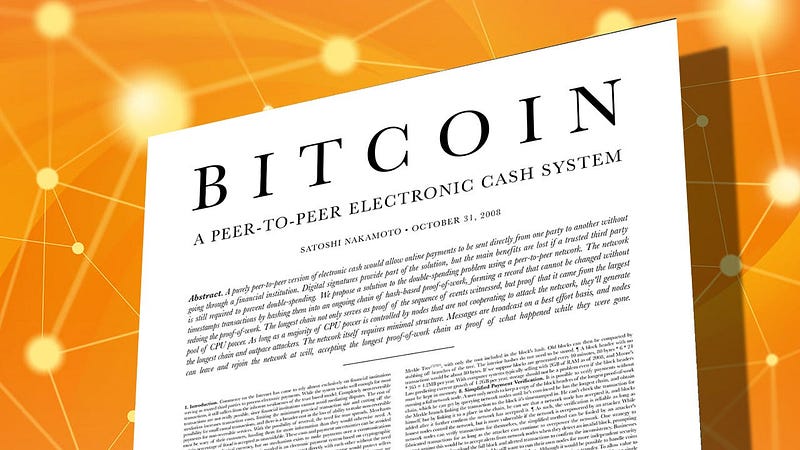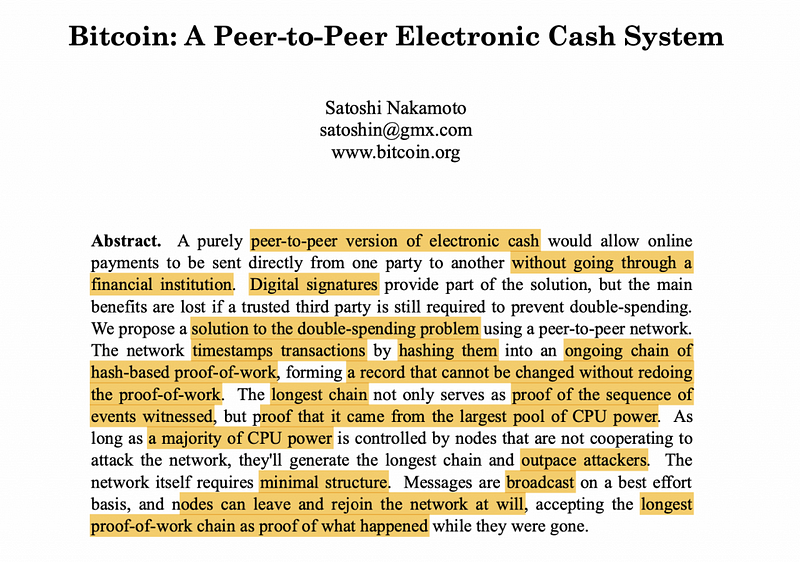# Celebrating 14 Years of the Bitcoin Whitepaper: Satoshi's Legacy
Written on
Chapter 1: The Birth of Bitcoin
Have you taken the time to read Satoshi Nakamoto's Bitcoin whitepaper? If not, it's highly recommended. The document offers insightful perspectives on the motivations behind Bitcoin's creation, showcasing Satoshi's genius in just eight pages.

On October 31, 2008, the world was grappling with the Great Recession, a financial crisis that had not been experienced for decades. Stock markets were in freefall, suggesting a collective yearning for a new financial paradigm—a reset, if you will. (Refer to my newsletter from two weeks ago for more context.) It was during this tumultuous period that Satoshi Nakamoto, the enigmatic coder, delivered a timely "Halloween treat" to the global community.
The Abstract
Even if you only peruse the abstract of the whitepaper, you'll grasp Satoshi's vision for a decentralized electronic cash system that operates on a peer-to-peer network, eliminating the need for traditional financial intermediaries. This concept was revolutionary.
To tackle the “double-spend” issue—where digital currency can be spent more than once—Satoshi introduced a method for timestamping all transactions on the network. This innovation led to the creation of an immutable chain of records, known as the blockchain ledger.

Where to Access the Whitepaper
Satoshi engaged with a cryptography mailing list called Metzdowd.com, where he discussed electronic payment systems with Hal Finney and others. He shared his whitepaper with this community, and it can still be found on bitcoin.org or by a quick online search.
Here’s a snippet from the mailing list post:
"I’ve been working on a new electronic cash system that's fully peer-to-peer, without the need for trusted third parties. The paper is available at: http://www.bitcoin.org/bitcoin.pdf"
Key Features:
- Prevents double-spending via a peer-to-peer network.
- No mint or other trusted entities required.
- Allows for participant anonymity.
- New coins generated through Hashcash-style proof-of-work.
- The proof-of-work mechanism also secures the network against double-spending.
Read the full paper here: http://www.bitcoin.org/bitcoin.pdf
Satoshi Nakamoto
Chapter 2: The Mystery of Satoshi's Identity
The true identity of Satoshi Nakamoto has been the subject of much speculation. Various theories propose different candidates: Was it Hal Finney, who denied it before passing? Or perhaps Craig Wright, who claims to be Satoshi but faced legal challenges? Some even speculate that Satoshi could be a collective rather than an individual.
One intriguing theory suggests that James A. Donald, a member of the Metzdowd.com mailing list, may be Satoshi. He was one of the first to respond to the whitepaper and raised a significant concern regarding scalability shortly after its release. Gerald Votta, director at Quantum Economics, noted, “The timing of Donald’s response—mere minutes after the Bitcoin White Paper was published—raises questions about how he could analyze it so rapidly.”
The Challenges of Traditional Finance
Before Bitcoin, executing financial transactions was fraught with complications. Satoshi outlined these challenges along with his proposed solutions in the whitepaper.
- Internet commerce relied heavily on financial institutions.
- Trust in financial institutions was paramount.
- Transaction fees were often exorbitant.
- Fraud was pervasive within traditional systems.
- Financial records were susceptible to manipulation.
How Bitcoin Addresses These Issues:
Satoshi designed a system that emphasizes proof rather than trust:
- Blockchain transactions are publicly available.
- Peer-to-peer transactions eliminate intermediaries.
- Records are immutable.
- There is no central authority, reducing points of failure.
- The network is resistant to attacks.
- Transaction costs are significantly lower.
The Role of Timestamping Technology
In his whitepaper, Satoshi acknowledged the contributions of two cryptographers, Stuart Haber and Scott Stornetta, whose pioneering work on timestamping digital documents laid the groundwork for blockchain technology. Their 1991 article, “How to Time-stamp a Digital Document,” highlights the extensive research on these issues.
Satoshi's Profound Conclusion
In his closing remarks, Satoshi encapsulated Bitcoin's potential to resolve the flaws of the existing financial system. Be sure to read the conclusion along with the abstract; one of his most notable statements is:
“The network is robust in its unstructured simplicity.” — Satoshi Nakamoto, 2008.
For real-time updates on Bitcoin blockchain transactions, check out: Blockchain.com/btc
Stay updated by subscribing on Substack—always free!
Explore all of Rick Mulvey’s stories and support thousands of other writers on Medium with your membership.